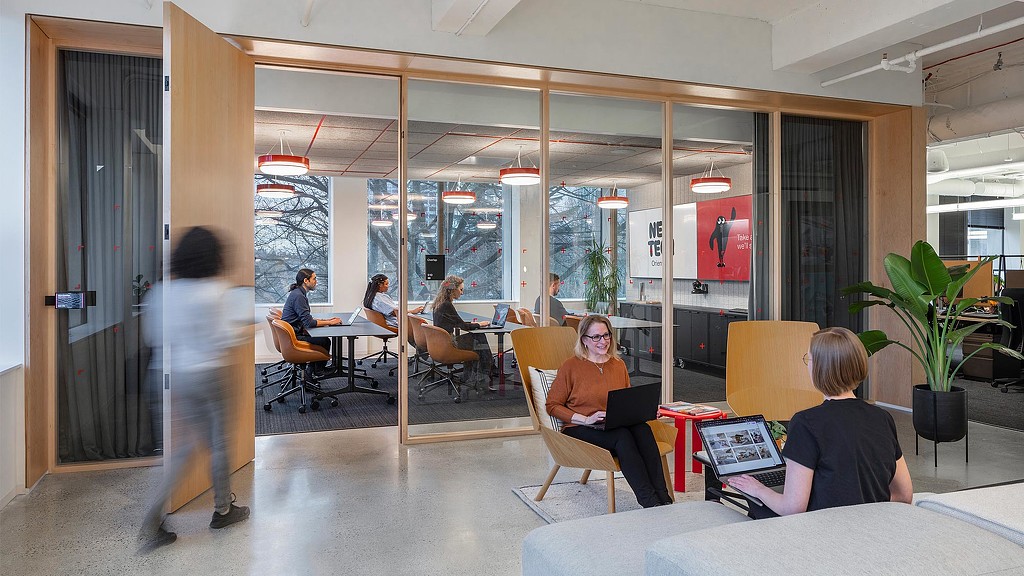Embodied Carbon Is Where Tech Must Tighten Its Belt
October 18, 2023 | By Diva Winje, Leah Macaulay, and Sarah Brengarth
The topic of embodied carbon within the architecture, engineering, and construction (AEC) world has accelerated at lightning speed over the past two years. Since the mid-2010s, operational carbon within the built environment has had a platform of increased importance, with large architecture firms like Gensler focused on reducing and tracking their EUI and LPD targets for all projects. Embodied carbon, however forgotten over the past decade, is an incredibly important factor when considering the built environment’s overall carbon footprint. In fact, the Carbon Leadership Forum suggests that “approximately 30% of all global carbon emissions are attributed to the building sector with at least 8% resulting from the manufacturing of construction materials.”
Embodied carbon is defined as the greenhouse gas emissions arising from the manufacturing, transportation, installation, maintenance, and disposal of all materials associated with the built environment. With many companies and corporations actively looking at and tracking their own carbon footprint, we see a rising ask from employers and consumers for more environmental transparency. In fact, a study by Label Insights found that over 94% of buyers are more likely to be loyal to a brand that’s completely transparent. Trends for hiring and retaining talented employees track similarly.
Embodied Carbon Strategies at Different Scales
At Gensler, our teams are committed to reducing the embodied carbon on a project, no matter the size or scope. Relying on valuable resources like the “AIA 10 Steps for reducing embodied carbon,” we understand the importance of strategies like reusing existing building elements, substituting carbon-intensive materials for low-carbon or even carbon sequestering materials, and salvaging existing materials to minimize waste that would otherwise go to landfill. As one example, a 5,000-square-foot tenant improvement project in the heart of Mountain View, California, utilized a variety of reuse strategies to maximize their carbon savings. It serves as a reminder that even modestly sized projects can make responsible choices, saving not only materials but their associated costs to have a small but significant impact.
The strategies used for this project include:
- Reuse of Existing Furniture: One of the main goals of the project was to incorporate as much of the existing furniture as possible, with 100% being reused for the initial phase. This not only eliminated the cost of temporary furniture but also helped to maintain the overall project schedule. More importantly, rather than discarding perfectly functional pieces, the design team saw an opportunity to reduce the demand for new resources and breathe new life into existing furniture stock.
- Reuse and Modification of Existing Millwork: In addition to reusing furniture, the project team demonstrated creativity by repurposing and modifying a large custom millwork piece that had served as a prototype for another project. By adapting this prototype to be a feature in the new design, the team minimized the need for new construction and conserved valuable materials.
- Close Collaboration With the Contractor: A key aspect of this process was the relationship between the design team and the contractor to salvage materials that would otherwise be demolished. The team worked closely with the contractor to identify existing materials, such as acoustic panels, which could be salvaged without compromising functionality or overall aesthetics. Existing elements were carefully removed and salvaged for reuse with some materials, like upholstery, being donated to local nonprofits like FabMo, an organization that rescues existing fabric for creative reuse and community services.
Another way to reduce embodied carbon on a project is to plan ahead and design to minimize demolition required in the future as the space needs adapt and change. A recent client did exactly this on a 160,000-square-foot building repositioning project in downtown Sunnyvale, California. The building owner recognized that the future of work is uncertain and that to stay competitive in the current market, their assets needed to remain flexible and accommodate several demising strategies that could respond to current market demands.
Together with Gensler, the client was able to strategically locate conference rooms and shared amenities on each floor plate to minimize the need to remove any interior partitions. By simply introducing a few new walls, the floor plate can go from a single-floor tenant to a multi-tenant set-up. Additionally, small conference rooms were sized so they could be easily converted to private offices, allowing for more market flexibility pending a future tenant’s programmatic requirements. The open office furniture system was designed as a kit-of-parts and laid out to align with the base building’s structural bays. This gives the owner the ability to easily mix and match different furniture pieces or swap entire furniture groupings to meet their tenants’ needs without ordering any new elements.
Embodied Carbon Tools and Resources
Embodied carbon on a project is best calculated by conducting a LCA (Life Cycle Assessment) study. Ballpark carbon reduction checks can be made using a quicker process of material take-off in Revit and setting a baseline for the project using a standard protocol. We can then gather environmental product declarations (EPDs) from manufacturers of construction products, materials, and finishes that pertain to the project and calculate the approximate embodied carbon reduction. Gensler has a tool that simplifies the process for our designers and architects to better inform design decisions. We also have updated our specifications, to be implemented on all projects in January 2024, to include rigorous sustainability standards for 12 interiors-focused materials/products. The Gensler Product Sustainability (GPS) StandardsTM will set the “baseline” or threshold embodied carbon emissions limit for a category of products, such as ACT ceiling or carpet, thus capping the allowable amount of embodied carbon. The standards also set a more rigorous embodied carbon reduction “goal” that a project team can aspire to for their material selection on the project.
With these tools and resources, coupled with our knowledge and expertise, we can provide clients with an assessment of their facilities’ embodied and operational carbon emissions. Whether a new building or an existing asset that is being repositioned, companies need to be able to report to their stakeholders and sometimes to the general public on carbon emission reduction efforts for the specific project or even their entire real estate portfolio.
In California, the CalGreen code amendment will require projects of a certain scale (depending upon building type and occupancy) to share their embodied carbon calculations and reduction efforts starting in July 2024. With the growth of carbon reporting moving forward in legislature in states like California and countries like the U.K. and Norway, tech companies and the building industry alike are racing to close the gap on embodied carbon and striving to meet sustainability targets that operational carbon reduction alone cannot achieve.
The role of architects and interior designers is ever-expanding to deliver unique experiences that meet and exceed their embodied carbon targets. From early goal setting to continual tracking and in-depth LCA studies, paired with continual communication on strategies for further reduction, design teams can partner with clients to further make their carbon goals a reality.
For media inquiries, email .



